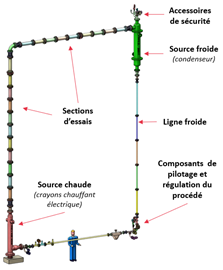PASTIS project
PASTIS (Passive Systems Thermalhydraulic Investigations for Safety) is a project that aims to study the physical phenomena involved in passive safety systems dedicated to the evacuation of residual power from a light water reactor in incident or accident situations.
This project benefits from State aid managed by the Agence Nationale de la Recherche under the France 2030 programme (reference ‘ANR-22-PAST-0001’). Experimental research will begin in 2026 and will be open to national and international collaborations.
Project characteristics
Completion dates : from 2022 to 2025, building the experimental platform. From 2026: carrying out experiments, developing thermal-hydraulic models and validating codes (systems such as CATHARE, ASTEC and CFD codes), which will then be used for expert appraisal.
Budget : the estimated budget is around €12.8m, of which €9m will be funded by the ANR. Experimental research will begin in 2026 and will be open to national and international collaborations.
Project Background
Since the accident at Japan's Fukushima Dai-ichi nuclear power plant, the nuclear community has become increasingly interested in ‘passive’ safety systems to deal with critical situations involving the prolonged loss of power supplies.
These systems do not require power sources to operate and can be used to manage a potential accident. One of the avenues of development and innovation being pursued by nuclear power plant designers and operators is the integration of passive systems into new-generation reactors, including small- and medium-power modular reactors (SMRs).
Preparing for expertise in passive systems
Back in 2016, IRSN looked into the reliability and safety benefits of such ‘passive’ systems based on natural phenomena (convection, condensation, etc.) and issued recommendations. In addition to these recommendations, IRSN believes it is essential to carry out anticipatory research aimed at understanding the phenomena involved in these passive systems. The aim is to prepare its technical appraisal of the safety dossiers relating to these systems that will be submitted by nuclear operators. In this context, IRSN is particularly interested in safety systems dedicated to the passive evacuation of residual power and the cooling of reactor containments.
Two research topics
A detailed analysis of current research programmes and experimental facilities available at national and international level has identified two priority research topics:
- convective phenomena in the hydraulic circuits of passive systems (primary circuit, secondary circuit) in incident or accident situations
- convection and condensation phenomena within an enclosure immersed in a large volume of water (immersion of an SMR reactor enclosure in a pool) in accident situations
Experimental platform
An experimental platform: ALCINA and KOKOMO, two dedicated facilities
These two research themes will be studied within an experimental platform located on the Cadarache site, offering the capacity to study the physical phenomena involved in the evacuation of the reactor's residual power in incident or accident situations. It will consist of two facilities that are sufficiently modular and scalable to be able to test different geometric and thermal-hydraulic configurations, and thus assess the performance and reliability of passive systems.
- A thermal-hydraulic loop, called ALCINA for ‘AnaLyse de la CIrculation NAturelle’ (Analysis of Natural Circulation), the aim of which will be to determine the losses of pressure in a pipe, in forced convection (with pump) and in natural circulation, in single phase or in two-phase in incidental or accidental situations.
ALCINA (AnaLyse de la Circulation Naturelle): a thermal-hydraulic loop dedicated to analysing the parameters influencing natural circulation in a two-phase loop and determining pressure drops.
- A confinement enclosure, called KoKoMo for ‘COndensation in a COntainment MOdel facility’, the aim of which will be to study convective movements and wall condensation simulating the principle of a Cold Wall Concenser (CWC), and more particularly the coupled effects of condensation and stratification.
KoKoMo (COndensation in a COntainment MOdel facility): enclosure cooled by a condensation wall dedicated to the study of convective movements and coupled condensation-stratification effects within an immersed enclosure.
Capitalisation
The knowledge acquired will be capitalised in particular in the numerical simulation tools used in France (CATHARE for normal and incidental operation and ASTEC for severe accident situations), through specific developments. This acquisition of knowledge will essentially be fed by new experiments dedicated to the study of physical phenomena of interest that are still too little known, following a scientific approach that is sufficiently generic not to be dependent on a specific system or component, since industrial concepts are not yet totally set in stone.
It also focuses on the phenomena involved in the concepts envisaged in France and Europe in the ‘medium term’, i.e. for third-generation pressurised water reactors (PWR-Gen-III) or integrated pressurised water reactors.



